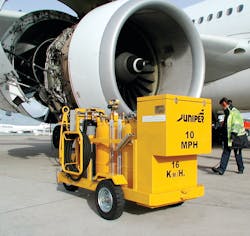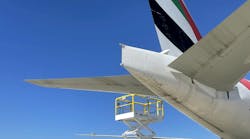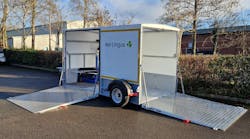Companies across the aviation sector are making changes to lower their carbon footprint. Fleets are being updated with cleaner, more fuel-efficient engines. However, this is a gradual process. Engines in existing aircraft must be cleaned regularly to mitigate the amount of pollution they produce.
Chris Marshall, director of A.T. Juniper, says clean engines use less fuel, resulting in a smaller amount of pollution per flight. He notes engines must be cleaned regularly, but frequency depends on where the aircraft flies.
“If the aircraft’s route takes it over salt water, there will be a buildup of salt deposits on the turbines, which will cause corrosion and lessen efficiency; the engine may have an oil leak or suffer a bird or insect ingestion – in all these cases, frequent engine washing will reduce the EGT (Exhaust Gas Temperature) before it reaches critical levels,” Marshall notes.
A.T. Juniper manufacturers its 2x25 gallon multi-engine compressor wash rig to accomplish the goal of keeping engines clean.
Users insert pairs of wash probes into the aircraft engine behind the fan blades and the hooked nozzles direct water into the core. A.T. Juniper designs and manufactures these wash probes specific to the engine type being washed. For many engines, there is a choice of either long or short versions.
The short probes require more engine preparation — opened thrust reverser doors, for example — but are easier to handle and, in many cases, can be stored on the rig. The long probes can be fitted in minutes and far less engine preparation is needed. To collect any waste water and associated contaminants from these engine washes, A.T. Juniper also manufactures and supplies a portable collection mat to be used in tandem with the wash rigs.
The heaters inside the wash rig heat the water to 70 degrees Celsius, which is the optimum temperature for engine washing without detergents — though these can be used if necessary, depending on how dirty the engine is. Once the rig is set up, it takes about one hour for the water to reach this temperature.
Rechargeable onboard nitrogen cylinders pressurize the liquid in the tanks, although there are optional Air Inlet Kits if customers want to connect shop air or nitrogen.
The 2x25 gallon multi-engine compressor wash rig is a low-pressure washer, meaning it can reach a maximum of 80 psi. Marshall says this is ideal for cleaning engines because higher pressure equipment might put unnecessary strain on the engine.
“Pressures up to 80 psi can give a range of different flows,” he says. “Various engines require different flow rates and users should consult the operation manual to determine the flow necessary for their engine.”
The wash procedure varies depending on the specific engine, but Marshall says customers typically wash the engine twice and rinse once.
“Normally, a standard CFM or LEAP engine might be three washes of two-minute periods with intervals of 10 minutes between wash cycles,” he explains.
“When performing a compressor wash, the aircraft engine is not actually started, so no fuel is used. The turbines are turned over using the aircraft’s starter,” Marshall continues. “This will turn the motor over to force the water or wash solution all the way through the engine with the 10-minute rest periods, allowing the starter to cool down.
“A lot depends on washing instructions within the aircraft maintenance manual,” he says. “If detergent is required, engine manufacturers may have their own recommendations, but that would be up to the end-user really. Our rigs are versatile enough to handle whatever the user requires.”
The wash rig requires a 115V/200V, three-phase, 400Hz electrical power supply to heat the water. Customers can hook up the equipment to a ground power unit (GPU) or hangar power supply, allowing employees to use it in various areas of the airport. A 24V battery installed in the rig’s electrical enclosure provides power for the interlock to operate.
The 2x25 gallon multi-engine compressor wash rig can service a multitude of engines, but some larger engines need a compressor wash rig with more capacity. A.T. Juniper also manufactures a 2x50 gallon multi-engine compressor wash rig to service those larger engines.
The 2x25 and 2x50 versions function the same way and A.T. Juniper works with its customers to determine which wash rig is right for them.
“The 2x25 gallon wash rigs have always proved extremely popular,” Marshall says. “Although since the introduction of the larger 2x50 gallon rig, production is now pretty much 50/50 between the two.”
Various MRO and military operations, airlines and aircraft engine manufacturers around the world use these multi-engine compressor wash rigs. A.T. Juniper works with its customers to ensure voltages are correct depending on the operation’s location.
“What engines are they washing? What aircraft? And then it’s basically about voltages and making sure that the equipment suits the requirements of the hangar or whether it’s off-grid or using a ground power unit,” Marshall notes.
A.T. Juniper also works with its customers to modify the wash rigs depending on their individual requirements. The JMP/CFM56/D/4777/C300 version was designed specifically to wash T56 engines on the C130 Hercules for the Belgian Air Force. The company also manufactures the JMP/CFM56/D/4777/C900 and C1000 static versions of the 2x25 gallon rigs for automated test cell use.
Each wash rig comes with a full technical manual that describes the maintenance procedures, operating instructions, detailed health and safety information and a full parts list to easily identify any spares that may be required. The manual also highlights which probes can be used with which engines and what pressure to use depending on the engine. Marshall notes customers should always consult the aircraft maintenance manual as well as the multi-engine compressor wash rig manual before cleaning an engine.
In addition to these manuals, A.T. Juniper also has a YouTube channel with videos explaining how to use the multi-engine compressor wash rigs. These videos serve as operation guides on how to set up the wash rigs and show the wash rigs in use.
“We believe strongly in the quality, versatility and cost-effectiveness of our products. Regular washing prolongs the life of an engine and reduces its carbon emissions,” Marshall says. “Plus, the benefits of owning and operating your own engine washing equipment as opposed to booking costly service washes are obvious – the flexibility to wash your engines when and where you want, all backed up by a company that is still supplying spares for rigs we manufactured in the 1950s.”




